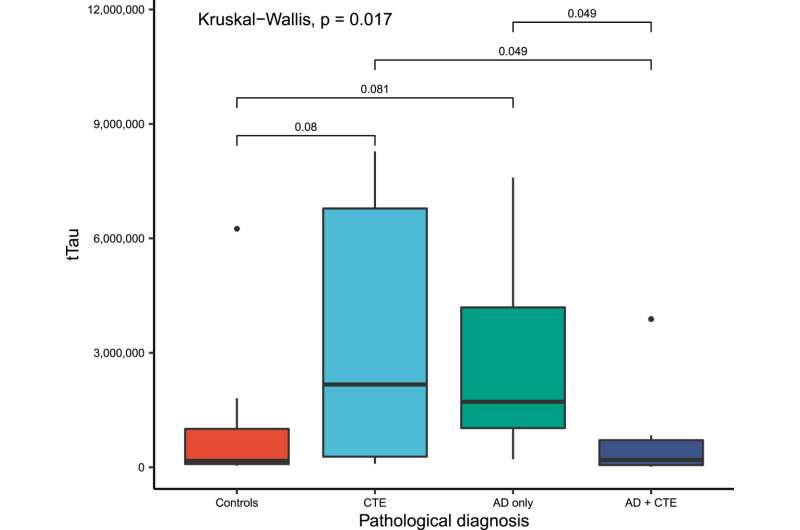This article has been reviewed according to Science X's editorial process and policies. Editors have highlighted the following attributes while ensuring the content's credibility:
fact-checked
peer-reviewed publication
trusted source
proofread
Significant correlation found between vitreous human biomarkers and Alzheimer's disease

New research from Boston Medical Center found a significant correlation between biomarkers in the vitreous humor of the eye and pathologically confirmed cases of Alzheimer's disease (AD) and Chronic Traumatic Encephalopathy (CTE) in post-mortem brain and eye tissue. This exploratory study indicates that biomarkers in the vitreous humor may serve as a proxy for neuropathological disease.
The incidence of dementias like AD continues to rise. As of 2021, 6.2 million North Americans above 65 years of age are suffering from AD, and this number is projected to reach 13.2 million by 2060. Diagnosis of both AD and CTE is based on symptoms, clinical exam findings, and cognitive testing, but the diagnoses are not confirmed until post-mortem examination of the brain.
In Alzheimer's disease, neuropathological changes occur decades before symptom onset, so by the time a patient is diagnosed, the therapeutic effect is often limited. Studying biomarkers that may predict disease and can be measured before symptoms develop is a significant priority in AD research.
Patients with eye disease have an increased risk for developing neurodegenerative disease, and several studies have established a link between neurodegenerative diseases and ophthalmic conditions like glaucoma, diabetic retinopathy, age-related macular degeneration, and cataracts. Patients with these eye conditions are known to have an increased risk of developing AD, so investigating biomarkers in this at-risk population is important in order to study their role in early diagnosis.
"To our knowledge, this is the first study to investigate the role of vitreous fluid biomarkers and link it to confirmed post-mortem brain tissue pathological examination of AD. In addition, this is the first study to find a link between vitreous fluid biomarkers and confirmed CTE. Our findings provide further evidence to support the potential role of vitreous biomarkers in early diagnosis and prognostication of diseases like AD and CTE," said Manju Subramanian, MD, an ophthalmologist at Boston Medical Center and an associate professor in ophthalmology at Boston University Chobanian & Avedisian School of Medicine.
Researchers in this study found a link of biomarkers, including total Tau and neurofilament light-chain (NfL) with pathologically confirmed AD and CTE. Alterations of these neurodegenerative proteins in the vitreous fluid confirm that the eye reflects neuropathological changes in the brain and further supports investigations into the eye's potential role in the diagnosis of these diseases.
The findings of this study build on the authors' previous work that biomarkers in vitreous fluid are linked to cognitive function in live patients with both normal cognition and mild cognitive impairment. These findings are also foundational for future studies to continue to investigate the role of biomarkers and other eye fluid in the diagnosis, prognostication, and management of diseases such as AD and CTE.
The work is published in the Journal of Alzheimer's Disease.
More information: Viha Vig et al, Vitreous Humor Biomarkers Reflect Pathological Changes in the Brain for Alzheimer's Disease and Chronic Traumatic Encephalopathy, Journal of Alzheimer's Disease (2023). DOI: 10.3233/JAD-230167





















